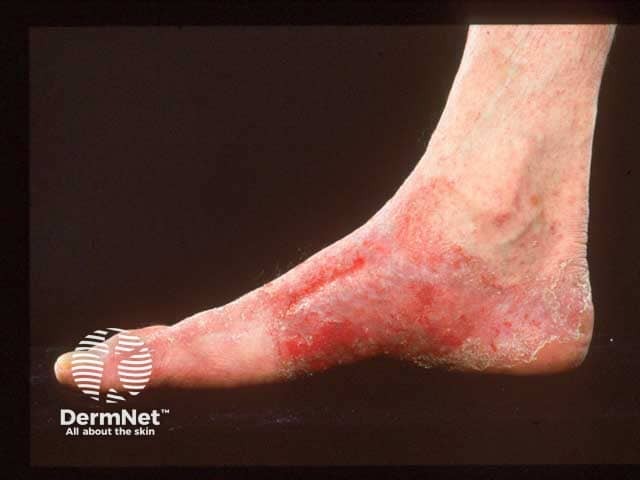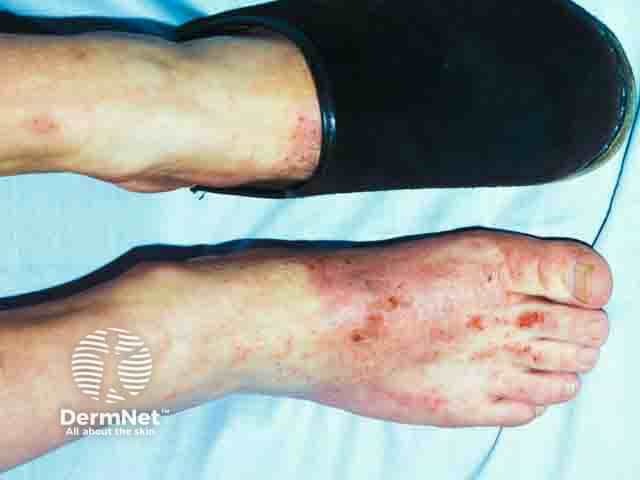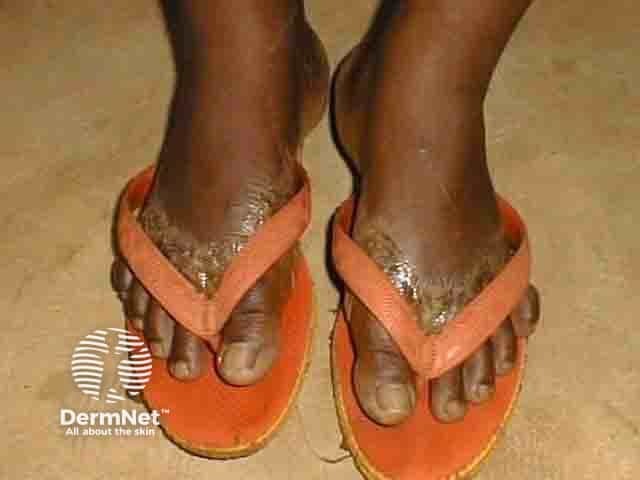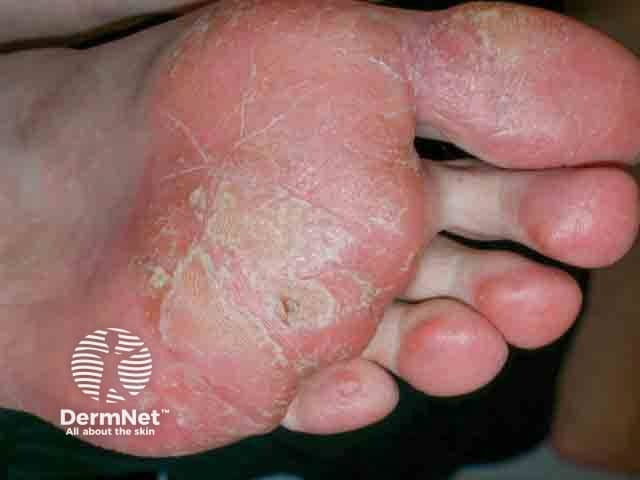Main menu
Common skin conditions

NEWS
Join DermNet PRO
Read more
Quick links
Shoe contact dermatitis — extra information
Shoe contact dermatitis
Author: Dr Harmony Thompson, Dermatology Registrar, Auckland District Health Board, July 2022. Copy edited by Gus Mitchell
Introduction
Causes
Features
Diagnosis
Differential diagnoses
Treatment
Prevention
What is shoe contact dermatitis?
Shoe contact dermatitis can be defined by dermatitis on the feet caused by any footwear consisting of multiple different materials. Contact dermatitis may be due to allergic (type IV hypersensitivity reaction) or irritant dermatitis.
Shoe dermatitis represents approximately 10% of all persons attending for patch testing. The culprit agent can range from products found in leather, colourants, rubber, or adhesive components, and can occasionally be mimicked by an allergy to agents on socks or stockings.

Symmetrical eczema on the dorsal feet, sparing the interdigital spaces, due to chromate allergy

Allergic contact dermatitis of the foot due to PTBP resin in a shoe adhesive

Allergic contact dermatitis due to a component of the shoe upper

Flip-flop allergy from a rubber accelerator

Contact allergy to the rubber thong in flip-flops

Allergic contact dermatitis on the sole due to PTBP resin
What causes shoe contact dermatitis?
Many different products and chemicals are used in the manufacturing of footwear. Factors that increase the risk of shoe contact dermatitis include heat, friction, occlusion, sweat, and atopy/allergy.
Allergy may be due to the material itself, such as leather or rubber, or it may be due to other constituents such as adhesives, decorations, sprays, insoles, or other products applied to the shoes.
Leather
-
Chromium salts:
- Present in more than 90% of tanned footwear leather samples.
- Chrome alum and chromium (III) sulphate are most frequently used.
- Identified by potassium dichromate patch testing.
- Biocides: fungicides and bactericides are used in the process of soaking, pickling, tanning, cleansing, and finishing in the leather production process:
- Octylisothiazolinone (OIT): a biocide added as a film preservative to protect surfaces
- 2-(thiocyano-methylthio) benzothiazole (TCMTB): used as a fungicide in leather manufacturing
- Acetophenone azine: may be used as a biocide (needs to be confirmed) and generally used in sports equipment
- Dimethyl fumarate (DMF): often contained in pouches in furniture or footwear boxes to prevent mould growth.
- Formaldehyde: used in white leather tanning.
Rubber
The following are used in accelerating rubber vulcanisation:
- Mercaptobenzothiazole (MBT)
- Zinc diethyldithiocarbamate (ZDEC)
- N-isopropyl-N0 -phenyl-p-phenylenediamine (IPPD)
- 1,3-diphenylguanidine (DPG)
- Dimethyl Thio-carbamoyl benzothiazole sulphate (DMTBS).
See rubber accelerator contact allergy for more information.
Added to neoprene products, eg, wet suits, gloves, swim goggles, shoe insoles:
Adhesive components
- P-tert-butylphenol formaldehyde resin (PTBP-FR): used in adhesives, it is the most prominent occupational allergen in shoemakers and repairers
- Colophony: often used in glues and finishes or as a tackifier
Other
- Shoe refresher sprays
- p-Phenylenediamine (PPD): Used as a rubber antioxidant and dye, also used in hair dyes and occasionally as a substitute for henna
- Dyes: Disperse Orange 3, Disperse Red 17, Disperse Blue, Acid Yellow, and many other colours can be tested in the textile dyes series
- Mercury (II) amidochloride: used as a disinfectant
- Tinuvin 880 (bis(2,2,6,6-tetramethyl-4 piperidyl) sebacate: used as an ultraviolet light absorber to extend lifetime from plastic weathering
- Nickel or cobalt buckles.
What are the features of shoe contact dermatitis?
Typically, the rash is symmetrical, with the volar and dorsal aspects of the feet affected, the toe flexural creases and instep often being spared. Sometimes allergy to particular shoe components dictates the distribution of dermatitis (eg, heel box constituents affect the heel, nickel in zips, buckles, and ski hooks affect the adjacent skin only).
Symptoms of contact allergic dermatitis may include swelling, redness, blisters or cracks in the skin, burning, itchiness, and pain.
The allergy can develop over a long period as the skin on the feet is repeatedly exposed to a specific allergen found in the shoe. However, it is not unusual to suddenly become allergic to a substance after months or years of exposure.
How is shoe contact dermatitis diagnosed?
Patch testing (allergy testing) is often utilised and may involve testing against both the standard allergen series as well as a special footwear series due to the many potential allergens present in the shoe.
Patch testing with portions of the patient’s shoes, alongside a shoe ‘screening tray’ of common additives and chemicals, is essential in making a correct diagnosis. See individual contact allergens for patch testing recommendations.
What is the differential diagnosis for shoe contact dermatitis?
- Atopic dermatitis
- Dyshidrotic dermatitis (pompholyx)
- Hyperkeratotic eczema
- Psoriasis
- Fungal infection, eg, tinea pedis
- Bacterial infection
- Lichen planus
- Juvenile plantar dermatosis
How is shoe contact dermatitis treated?
Shoe contact dermatitis should clear rapidly once the offending allergen is removed. This will mean not being able to wear the offending shoes ever again unless the allergen can be removed or avoided in new footwear. For example, allergy to chromate in leather can be avoided by choosing vegetable-tanned leather items.
The eczematous component is treated with topical steroids and emollients. Antibiotics or antifungals may need to be used if there is a suspected infection.
For more information, see contact dermatitis.
What should I do to avoid shoe contact dermatitis?
The best way to prevent shoe contact dermatitis is by avoiding all footwear that contains the culprit allergen.
Some steps to reduce reactions include:
- Controlling foot perspiration using antiperspirants
- Vegetable-tanned shoes
- Replace rubber insoles with a foam sole, eg, urethane foam cork or leather insole
- Air shoes regularly, and do not keep them boxed up with DMF sachets
- Sometimes wearing two pairs of socks minimises contact with the allergen.
In some countries, broad categories of allergens (leather and rubber) are identified on the packaging of new shoes. However, identification of known culprit allergens, even after contacting the manufacturers, can be difficult.
Bibliography
- Hedberg YS, Wei Z, Matura M. High release of hexavalent chromium into artificial sweat in a case of leather shoe-induced contact dermatitis. Contact Dermatitis. 2020;82(3):179–81. doi:10.1111/cod.13425. Journal
- Hulstaert E, Bergendorff O, Persson C, et al. Contact dermatitis caused by a new rubber compound detected in canvas shoes. Contact Dermatitis. 2018;78(1):12–17. doi:10.1111/cod.12886. Journal
- Matthys E, Zahir A, Ehrlich A. Shoe allergic contact dermatitis. Dermatitis. 2014;25(4):163–71. doi:10.1097/DER.0000000000000049. Journal
- Traidl S, Werfel T, Ruëff F, et al. Patch test results in patients with suspected contact allergy to shoes: Retrospective IVDK data analysis 2009–2018. Contact Dermatitis. 2021;85(3):297–306. doi:10.1111/cod.13868. Journal
On DermNet
Other websites
- Allergic contact dermatitis — Medscape Reference, the online textbook
